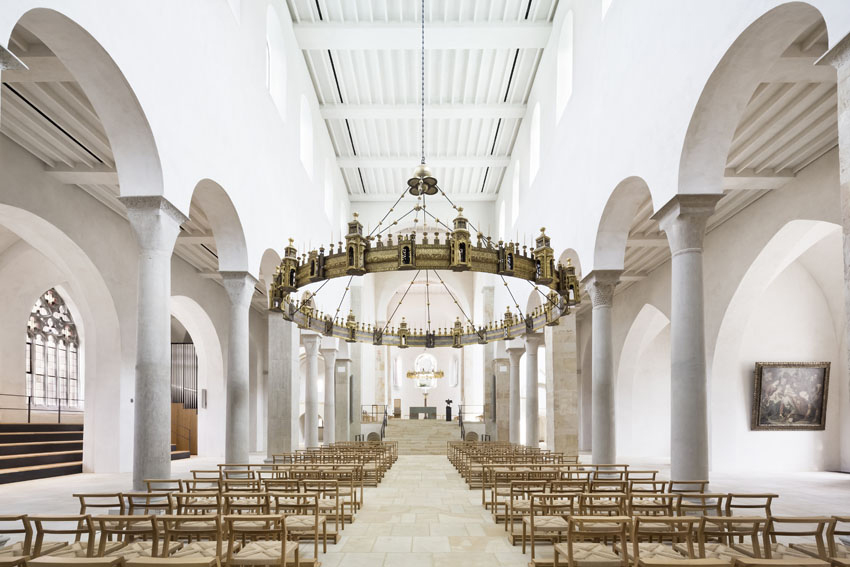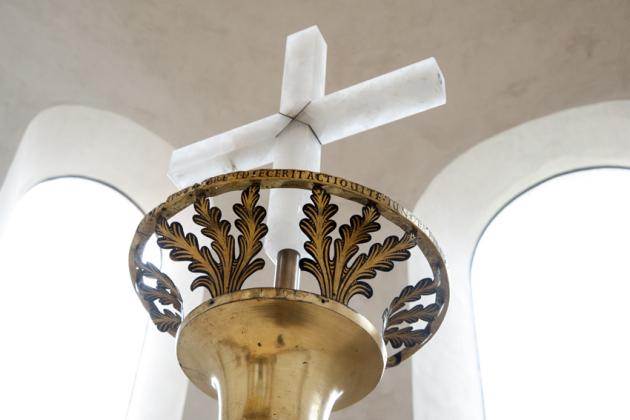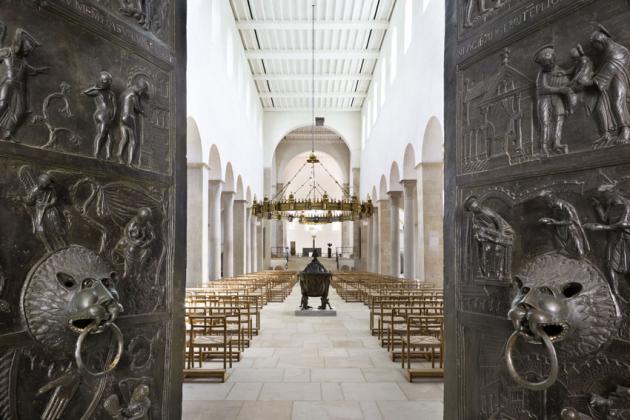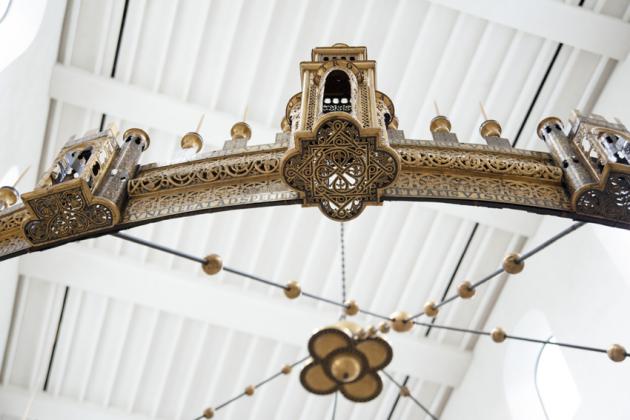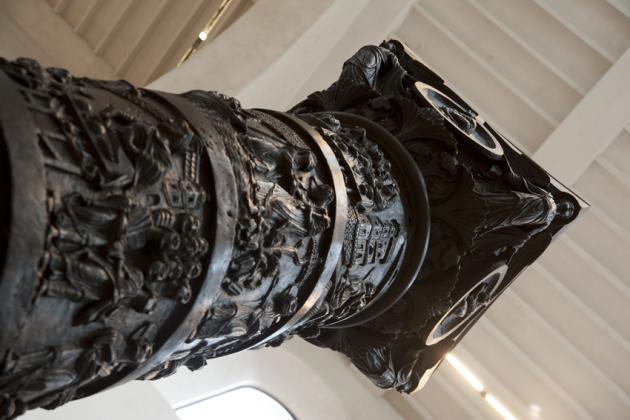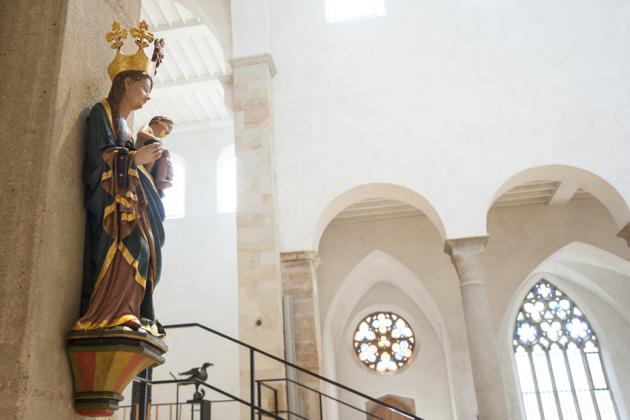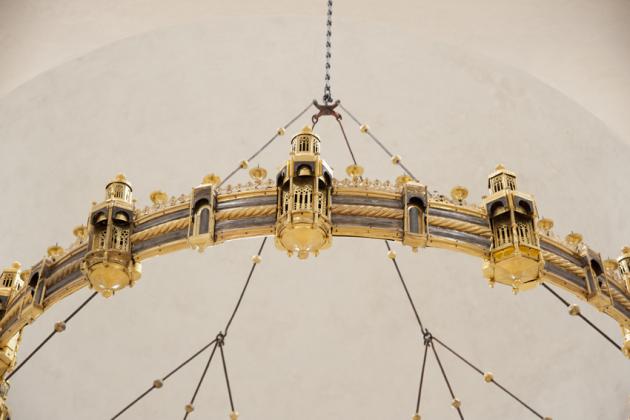Redesigning the Cathedral interior
Light, clear and spacious – these are the first things one notices on entering the redesigned Hildesheim Cathedral. The original Roman cathedral building has had its interior completely redesigned according to a design concept from Schilling Architekten, Cologne – from the Bernward Doors and the floor, the inner chamber and the chapel to the plaster and the lighting plan in the ceiling.
Simplicity is the dominant impression, although the Cathedral is not significantly emptier than before and the medieval works of art are naturally back in their original place, such as the imposing Hezilo chandelier in the middle of the church nave. Yet another chandelier, the Thietmar chandelier, has been added to the altar room, the oldest of the four remaining medieval chandeliers in Germany. It is now returning to the Cathedral from the neighbouring former St. Antonius Church.
The impression of simplicity is created above all by the light materials, the new plaster, the new windows and the seating designed specifically for the Cathedral. Instead of the old pews, there are now rows of chairs with approximately 200 chairs made of light oak with a resilient tissue cover. More chairs can be arranged when so required so that the Cathedral can seat up to 600 people. This type of church seating already has a long tradition in other countries, such as France. The London-based German designer Martin Ebert designed the delicate Hildesheim Cathedral chair. The chairs match new and light seating for the Bishop, the priests, service assistants and altar servers.
New plaster was developed especially for the Cathedral
The floor is made from Posta sandstone from the Elbe near Dresden. This is a light but robust sandstone that will withstand the countless worshippers and tourists. The floor level, which was raised 30 centimetres during previous reconstructions (1950 to 1960), has been lowered again. This makes the space seem more open than before. The previous proportions of the pillars have now been restored and their bases have been reconstructed.
The new plaster also adds to the lighter sense of space. The previous plaster had to be completely renewed. This was the only way to prevent long-term damage to the building. A plaster was developed specifically for the Hildesheim Cathedral that meets all modern requirements: appropriate to the monument and the masonry, easy to maintain, environmentally friendly and gentle for people.
The Ludwig Baur mosaic from the 1950s in the apse, on the front end of the tabernacle, has disappeared under this plaster. The beautifully structured concrete ceiling from the time of reconstruction has been covered with the same plaster as was the rest of the interior. This creates a uniform, calm image.
More prominent positions for Hezilo chandelier and font
One of the most remarkable changes is the new position of the imposing Hezilo chandelier which, with a diameter of six metres, is the largest of the remaining medieval chandeliers. It is now in the nave of the Cathedral. The Romanesque baptismal font is there too. Both were previously placed in the middle of the church and have now regained their central position and increased stature. This epitomises the central importance of the font for Christians – acceptance into the community of believers – and the goal of all Christians: acquiring a place in God’s Kingdom. The beautifully decorated Hezilo chandelier is a symbol of holy Jerusalem, which the Bible uses to describe God’s Kingdom, which man hopes to reach after death.
One of the other key places in the tabernacle is the altar room with the ambo, the pulpit, and the altar. This is where the most important events happen: the preaching of the word of God in the reading of biblical texts (at the ambo) and the celebration of Eucharist, the transformation of the bread (communion wafer) and wine into the body and blood of Jesus Christ in accordance with the Catholic faith (at the altar). The Cathedral has acquired a new main altar designed specifically by the globally renowned artist Ulrich Rückriem. It was made from a single five-ton block of Anröchte dolomite. At the Ambo, tradition and modernity, old and new, are blended together. The bronze eagle lectern from the 13th century, which is the most famous of its kind, has a new base that matches the Cathedral’s modern look.
The Hildesheim Cathedral collection is one of the world’s most important
Hildesheim Cathedral has an outstanding collection of medieval works of art. The Hildesheim Cathedral collection is one of the most important in the world and one of the few remaining comrehensive medieval collections. For the reconstruction period, a large proportion of the collection was stored and shown in several museums. One of the high points was the exhibition "Medieval Treasures from Hildesheim“, which opened in September 2013 in the renowned Metropolitan Museum of Art in New York with pieces of the Cathedral collection. The Director of the Metropolitan Museum of Art (MET), Thomas P. Campbell, was excited about the exhibits. Campbell said at the opening that the Metropolitan Museum has a long tradition of important exhibitions on loan from medieval art collections, giving examples of earlier exhibitions with art from San Marco in Venice, the Abbey of Saint-Denis and the Vatican: “But the loans from Hildesheim stand out even in this illustrious company.“ The exhibition was a huge success: 80,000 visitors came to see the Cathedral collection. The New York Times called the exhibition one of the high points of the year in art.
The Tagesthemen newspaper reported on the exhibition New York.
While many of the liturgical objects, paraments and other treasures that have been hitherto partially in use are usually found in the Cathedral museum, some of the most important works are a fixed and integral components of the Cathedral furnishings. These include, above all, the Bernward Doors and the Bernward Column, and also the Irmisul, the Inkwell Madonna and the founding reliquary.
Bernward Doors with a rich iconographic programme
The Bernward Doors date back to the holy Bishop and patron of the diocese Bernward (circa 960-1022). They are composed of 2 doors and are almost five metres tall. Their rich iconographic arrangement presents scenes from the Old and New Testament. The Bernward Doors date back to the year 1015 according to the inscription. It will therefore be 1000 years old in 2015. What is special about the huge doors is that they were cast in one piece. The Bernward Doors were hung facing outward during the Cathedral restoration process (between the church nave and the Westparadies). This had them back in their original place. For the purposes of conservation – to protect the images – the door was hung with the iconography facing inwards following the renovations.
Sketches of the Bernward Column made by Bishop Bernward
The Bernward Column – also known as the Christ Column – has a rich iconographic arrangement and can be traced back to sketches by Bishop Bernward. The Bernward Column is almost four metres tall and has a diameter of almost 60 centimetres. It depicts the public works of Jesus Christ, from baptism in the Jordan by John the Baptist – the first time Jesus appeared as an adult– to his triumphant arrival in Jerusalem, shortly before his crucifixion and resurrection. The Bernward Column has been returned to its place in the south church nave following the Cathedral’s restoration.
Legends surround the Irminsul
Another pillar that has a supporting role in Hildesheim Cathedral: the Irminsul. Its past is a mystery. We can only be sure that it dates from the Middle Ages. The pillar, which is almost 2.5-metres high, appears to have initially been used as a special light. Since the 17th century, it was crowned with a statue of Mary and a chain of 14 candles. Over the past five decades the Irminsul stood on the Godehardichoir. Now it has been returned to the high chancel, where it completes the visual axis from the Bernward Doors to the apse. The figure of Mary has been replaced by a rock crystal cross – the central symbol of Christianity.
The Inkwell Madonna has been restored
The special features of Hildesheim Cathedral include an unusual statue of Mary with the Christ child: what is known as the “Inkwell Madonna”. The life-size wooden sculpture appeared in 1430. The lively boy bows to the observer. He holds a quill in his hand and has parchment on his knee. His mother holds the inkwell for him. This first of all touches upon the medieval motif of Jesus learning, but also demonstrates that the Christ child already possesses all of God’s wisdom. During the Cathedral restoration, the Inkwell Madonna was also completely restored. At Hanover Klosterkammer, the restorer, Roksana Jachim was able to bring out the colours that the Madonna would have had in the Baroque period – the outer garment in blue and the undergarment in pink. The statue now has a much more lively and different expression. The Inkwell Madonna once again has a prominent position at the crossing pillar.
Precious collection pieces in the Gothic side chapels
Not only the Cathedral’s nave has been significantly altered, but also the nine Gothic side chapels. They are all level with the nave. This means that there are no steps between both areas of the church. In future, it will hold additional precious Cathedral objects, but also provide space for the new choir organ and personal prayer.
Image gallery: The chapels and their collections at a glance
Two new organs for cathedral music
As music, with its celebratory and purely emotional effect, plays a key role in liturgy, worship and prayer, it is important for an episcopal church to have an organ that sounds good. Hildesheim Cathedral Music received two new organs as part of the restoration – with a new main organ that contains approximately 80 per cent of the old Cathedral organ. Both organs were made in the workshop of the organ-building company Seifert in Kevelaer and were funded thanks to generous donations. The main organ, as what is known as a swallow’s nest organ, hangs over the main door and the Bernward Doors. The choir organ, intended for use in everyday worship, may be found in the Chapel of Grace.
New lighting design for the Cathedral
The new additions following the Cathedral’s restoration include new windows and new lighting with the latest technology. Both contribute to the design concept of the light, bright Cathedral. The tabernacle has windows that were created with the latest technology based on medieval grisaille painting – produced in a spectacular, computer-controlled procedure. The transparent windows on the outside create a connection between the Cathedral's interior and the outside world in the Cathedral square – and vice versa. The windows, which are almost four metres tall and two metres wide, were manufactured by the Paderborn company Glas Peters and were cast in an oven in one piece.
The lighting design was also specifically developed for the Cathedral. The latest technology was used to do so. Eighty per cent of the lighting is installed in the roof trusses. Other light sources almost seem to disappear in the skirting boards. This means that the sacred space is undisturbed by spotlights and lamps. Spectacular: almost every worship and prayer situation is programmed into the computer. The sexton can operate it easily with a swipe of the finger, as if they were using a tablet PC. New LED technology enables elements or scenes to be pinpointed even from a great height. Theoretically, this could even be the fingertip of the reader who is leafing through the lectionary. The engineering company Walter and Michael Bamberger from near Eichstätt developed the lighting design in accordance with the architects’ vision.


